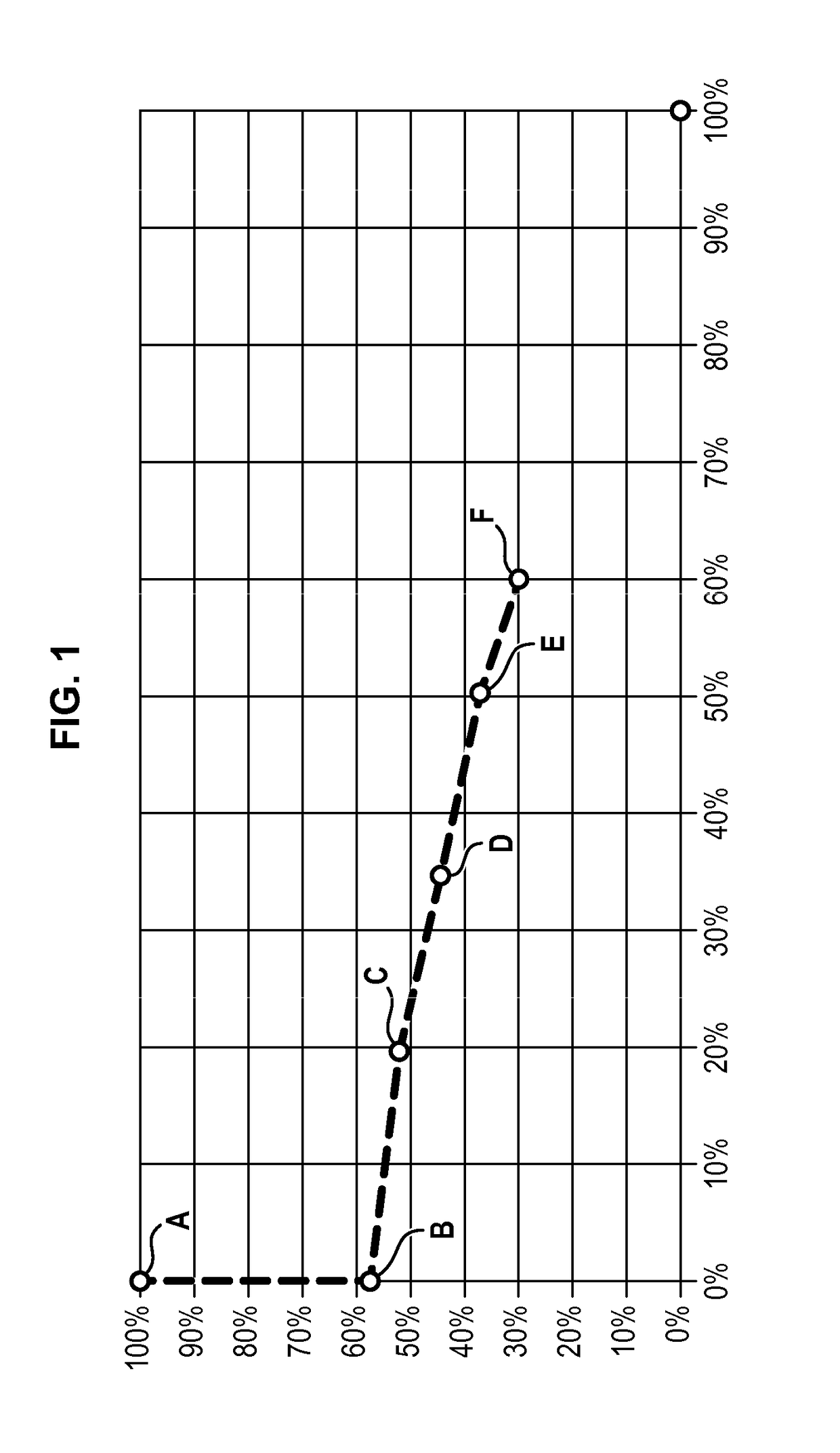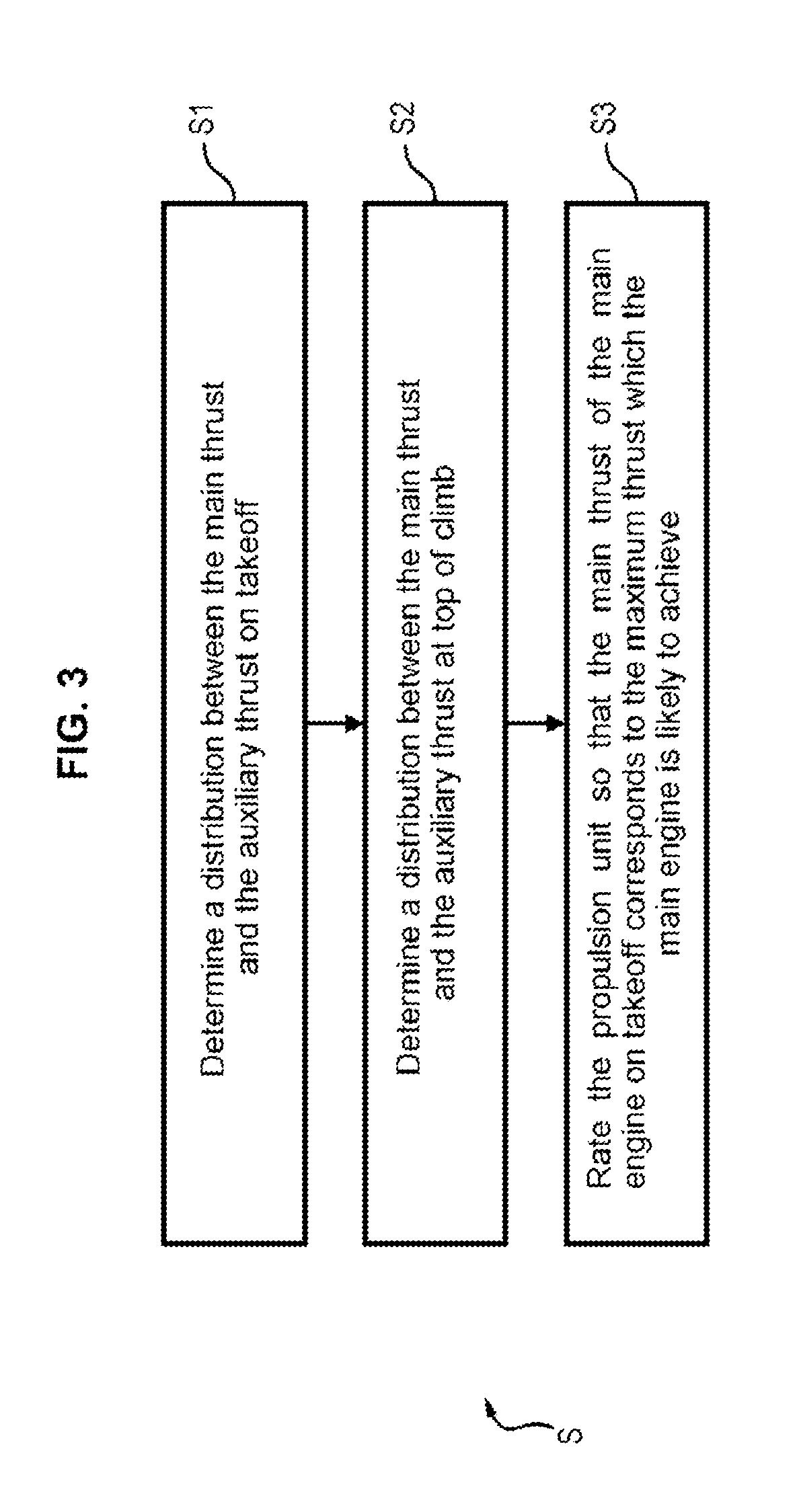Method for rating a propulsion unit comprising a main engine and an auxiliary engine
a technology of propulsion unit and main engine, which is applied in the field of engine rating, can solve the problems of less thermodynamic (and therefore energetic) efficiency of engine, less thrust of engine, and greater specific consumption of engine, and achieve the effect of not optimal thermodynamic efficiency in the other flight phases, and less thrust of engin
- Summary
- Abstract
- Description
- Claims
- Application Information
AI Technical Summary
Benefits of technology
Problems solved by technology
Method used
Image
Examples
first embodiment
[0057]In a first embodiment, the propulsion unit 2 can be rated such that, during the take off operating condition, the thrust provided by the propulsion unit 2 is obtained at 38% to 42% by the auxiliary engine 4 during the take off operating condition (the complement being provided by the main engine 3) and at 100% by the main engine 3 during the top of climb operating condition.
[0058]This first embodiment is particularly adapted for the aircraft 1 having a mission of short-haul type. In fact, the thermodynamic cycle of the main engine 3 is optimised at top of climb, which improves its specific consumption in comparison with a conventional engine, especially in the operating conditions of top of climb and cruise, without as such needing a large-size auxiliary engine 4, reducing the bulk of the propulsion unit 2 as well as the overload resulting from the addition of an auxiliary engine 4.
second embodiment
[0059]In a second embodiment, the propulsion unit 2 can be rated such that the thrust provided by the propulsion unit 2 is obtained at 47% to 49% by the auxiliary engine 4 during the take off operating condition and at 18% to 21% by the auxiliary engine 4 during the top of climb operating condition, the rest of the thrust being provided by the main engine 3.
[0060]This second embodiment is particularly adapted for the aircraft 1 having a mission of short-haul to medium-haul type. In fact, the thermodynamic cycle of the main engine 3 is improved at top of climb and optimised to the point of maximal corrected engine speed of the fan (N1K), which corresponds to an intermediate operating condition between the top of climb operating condition and the operating cruise condition which is representative of the average use of the plane on this type of mission.
[0061]Typically, the specific consumption of a propulsion unit 2 rated in keeping with this embodiment is further reduced relative to t...
third embodiment
[0062]In a third embodiment, the propulsion unit 2 can be rated such that the thrust provided by the propulsion unit 2 is obtained at 52% to 55% by the auxiliary engine 4 during the take off operating condition and at 33% to 36% by the auxiliary engine 4 during the top of climb operating condition, the rest of the thrust being provided by the main engine 3.
[0063]This third embodiment is particularly adapted for the aircraft 1 having a mission of the medium-haul to long-haul type. In fact, the thermodynamic cycle of the main engine 3 is improved at top of climb and optimised at the point of engine speed of the fan corresponding to 95% of its corrected maximal speed which corresponds to an operating condition of start of cruise of average length, representative of the average use of the plane on this type of mission.
[0064]Typically, the specific consumption of a propulsion unit 2 rated in keeping with this third embodiment is further reduced relative to that of the propulsion unit 2 a...
PUM
 Login to View More
Login to View More Abstract
Description
Claims
Application Information
 Login to View More
Login to View More - R&D
- Intellectual Property
- Life Sciences
- Materials
- Tech Scout
- Unparalleled Data Quality
- Higher Quality Content
- 60% Fewer Hallucinations
Browse by: Latest US Patents, China's latest patents, Technical Efficacy Thesaurus, Application Domain, Technology Topic, Popular Technical Reports.
© 2025 PatSnap. All rights reserved.Legal|Privacy policy|Modern Slavery Act Transparency Statement|Sitemap|About US| Contact US: help@patsnap.com



